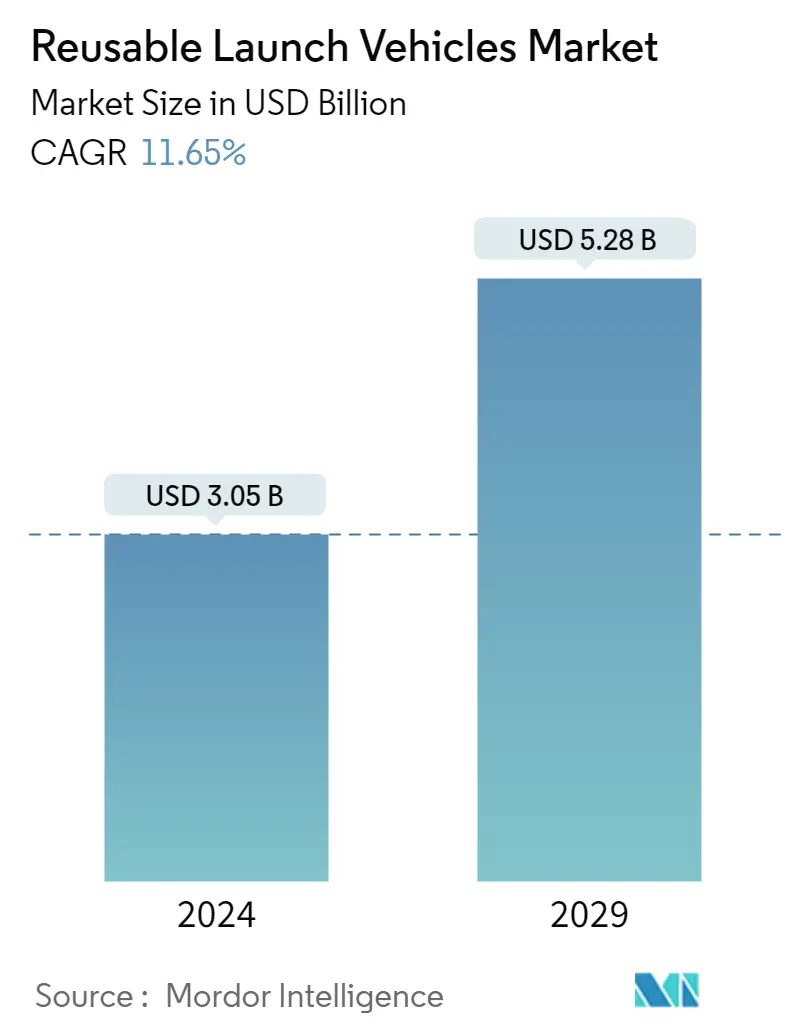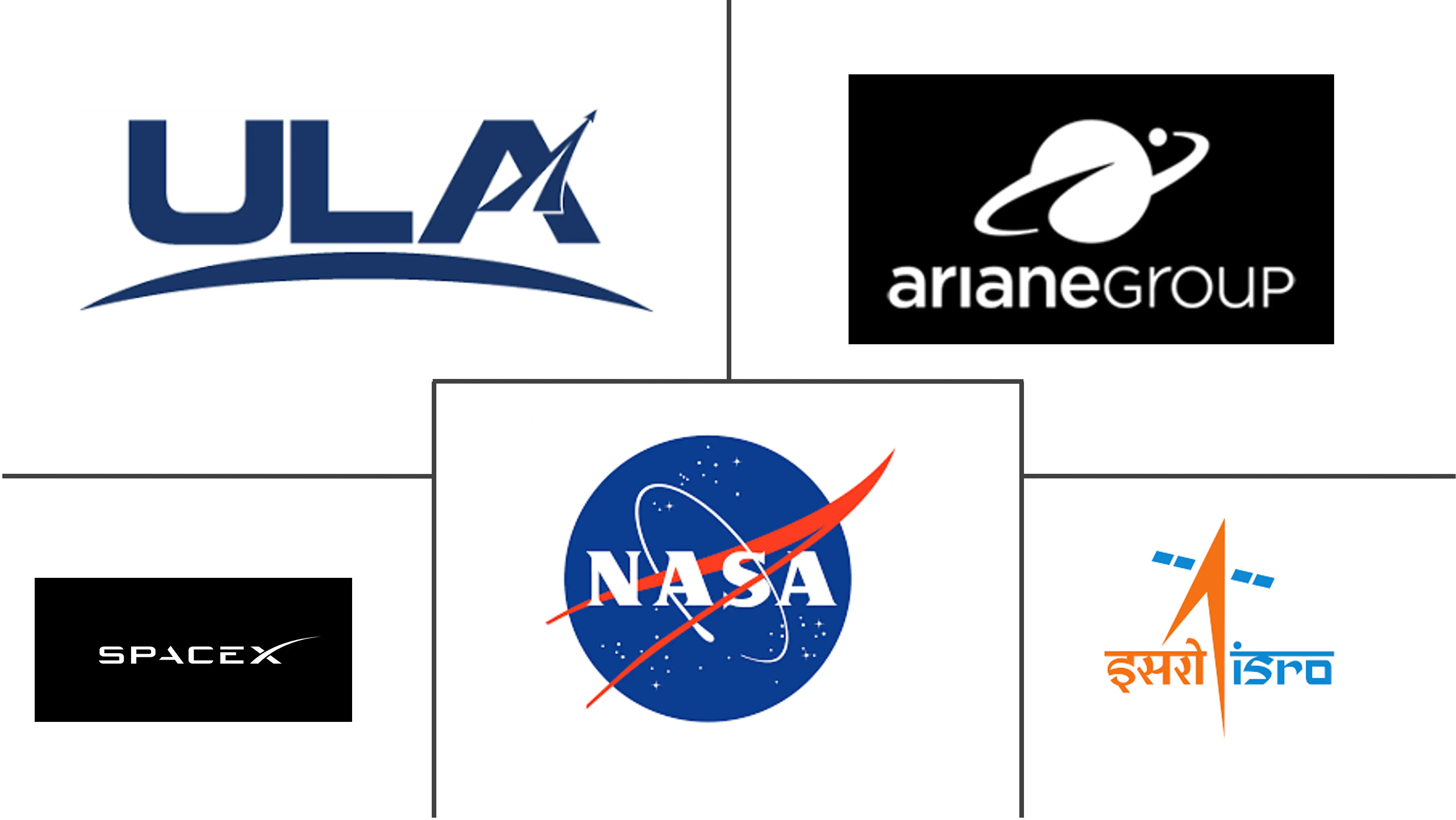Market Size of Reusable Launch Vehicles Industry

| Study Period | 2019 - 2029 |
| Market Size (2024) | USD 3.05 Billion |
| Market Size (2029) | USD 5.28 Billion |
| CAGR (2024 - 2029) | 11.65 % |
| Fastest Growing Market | Asia-Pacific |
| Largest Market | North America |
Major Players
*Disclaimer: Major Players sorted in no particular order |
Reusable Launch Vehicles Market Analysis
The Reusable Launch Vehicles Market size is estimated at USD 3.05 billion in 2024, and is expected to reach USD 5.28 billion by 2029, growing at a CAGR of 11.65% during the forecast period (2024-2029).
The demand for satellite networks and commercial and defense application services has increased. This has resulted in a rise in satellite launches for military surveillance, communication, navigation, earth observation, and scientific research, among others. Space agencies and private companies have been trying to reduce the costs of satellite launching systems over the past few years. The primary driver for the reusable launch vehicle market is cost efficiency. Reusable launch vehicles offer significant cost savings over traditional rockets by enabling multiple launches with the same launch components. The cost-effectiveness makes space missions more affordable for governments, commercial end-users, and scientific research institutions.
Rapid advancement in space technology is driving innovation in launch vehicle design, materials, and propulsion systems. These technological advancements are enhancing the reliability, performance, and reusability of launch vehicles, leading to increased adoption in the market. There is a growing demand for space exploration and utilization due to advancements in satellite technology, increasing space tourism, and the quest for scientific discovery. Reusable launch vehicles play an important role in these applications by providing reliable and cost-effective access to space.
However, the initial investment and development costs for reusable launch vehicle technology are substantial. OEMs and governments are required to invest significant resources in research, development, and infrastructure to bring reusable launch vehicles to market, which can act as a market restraint. The space tourism industry represents a promising opportunity in the reusable launch vehicle market. With the increasing interest of private individuals in experiencing space travel, there is a growing market for reusable launch vehicles to transport passengers to suborbital and orbital destinations.
Reusable Launch Vehicles Industry Segmentation
A space launch system designed to recover all or part of the system post deploying a satellite in orbit is termed a reusable launch vehicle (RLV). The primary objective of an RLV is to drive down the associative launch costs of the satellites by successfully recovering exhausted critical systems and components. To depict a comprehensive outlook, the study incorporates a detailed analysis of yearly satellite launches and the models of launch vehicles used for orbital deployment. The study also considers the ongoing R&D efforts divested by the market players to develop new RLV variants.
The reusable launch vehicles market is segmented based on type, configuration, and geography. By type, the market is segmented into partially reusable and fully reusable. By configuration, the market is segmented into single-stage and multi-stage. The report also covers the market sizes and forecasts for the reusable launch vehicles market in major countries across different regions.
For each segment, the market size is provided in terms of value (USD).
| Type | |
| Partially Reusable | |
| Fully Reusable |
| Configuration | |
| Single-Stage | |
| Multi-Stage |
| Geography | ||||||||
| ||||||||
| ||||||||
| ||||||||
| ||||||||
|
Reusable Launch Vehicles Market Size Summary
The reusable launch vehicles market is poised for significant growth, driven by the increasing demand for satellite launches and the need for cost-effective space access solutions. The market is experiencing a surge in interest due to advancements in space technology, which are enhancing the reliability and performance of launch vehicles. This has led to a rise in the adoption of reusable launch vehicles, as they offer substantial cost savings over traditional rockets by allowing multiple launches with the same components. The growing demand for space exploration, satellite deployment, and space tourism further fuels the market's expansion. However, the high initial investment and development costs pose challenges, requiring substantial resources from original equipment manufacturers (OEMs) and governments.
Key players in the market, such as SpaceX, ISRO, and ArianeGroup, are actively investing in research and development to advance reusable launch vehicle technology. These companies are expanding their geographical reach and securing contracts with emerging satellite operators, which bolsters their market presence. The development of fully reusable launch vehicles, like SpaceX's Starship and ISRO's RLV-TD, highlights the industry's focus on reducing costs and environmental impact. As these vehicles become more reliable, they are expected to support new applications, including space mining and interplanetary exploration. The market's growth is further supported by investments in infrastructure and technology development, as seen with companies like Stoke Space Technologies and iSpace, indicating a robust future for reusable launch vehicles.
Reusable Launch Vehicles Market Size - Table of Contents
-
1. MARKET DYNAMICS
-
1.1 Market Overview
-
1.2 Market Drivers
-
1.3 Market Restraints
-
1.4 Industry Attractiveness - Porter's Five Forces Analysis
-
1.4.1 Bargaining Power of Suppliers
-
1.4.2 Bargaining Power of Buyers/Consumers
-
1.4.3 Threat of New Entrants
-
1.4.4 Threat of Substitute Products
-
1.4.5 Intensity of Competitive Rivalry
-
-
-
2. MARKET SEGMENTATION
-
2.1 Type
-
2.1.1 Partially Reusable
-
2.1.2 Fully Reusable
-
-
2.2 Configuration
-
2.2.1 Single-Stage
-
2.2.2 Multi-Stage
-
-
2.3 Geography
-
2.3.1 North America
-
2.3.1.1 North America
-
2.3.1.2 Canada
-
-
2.3.2 Europe
-
2.3.2.1 United Kingdom
-
2.3.2.2 Germany
-
2.3.2.3 France
-
2.3.2.4 Italy
-
2.3.2.5 Russia
-
2.3.2.6 Rest of Europe
-
-
2.3.3 Asia-Pacific
-
2.3.3.1 China
-
2.3.3.2 India
-
2.3.3.3 Japan
-
2.3.3.4 South Korea
-
2.3.3.5 Rest of Asia-Pacific
-
-
2.3.4 Latin America
-
2.3.4.1 Brazil
-
2.3.4.2 Mexico
-
2.3.4.3 Rest of Latin America
-
-
2.3.5 Middle-East and Africa
-
2.3.5.1 Saudi Arabia
-
2.3.5.2 United Arab Emirates
-
2.3.5.3 Israel
-
2.3.5.4 South Africa
-
2.3.5.5 Rest of Middle-East and Africa
-
-
-
Reusable Launch Vehicles Market Size FAQs
How big is the Reusable Launch Vehicles Market?
The Reusable Launch Vehicles Market size is expected to reach USD 3.05 billion in 2024 and grow at a CAGR of 11.65% to reach USD 5.28 billion by 2029.
What is the current Reusable Launch Vehicles Market size?
In 2024, the Reusable Launch Vehicles Market size is expected to reach USD 3.05 billion.

